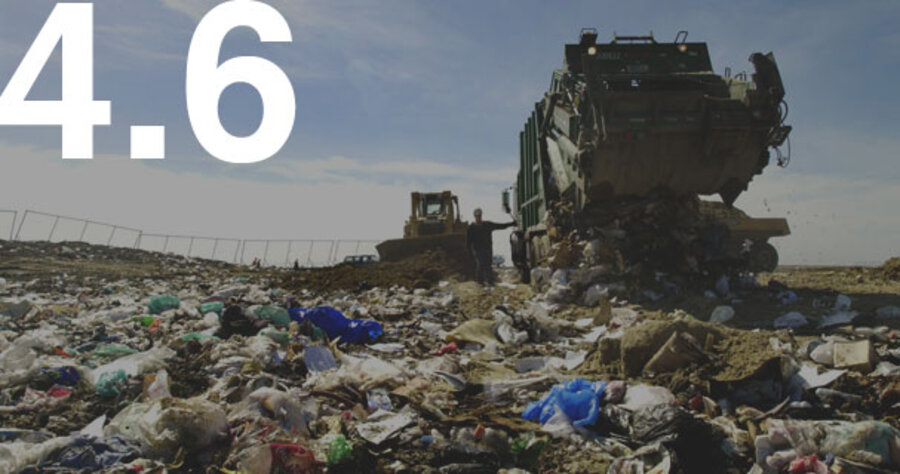Today's number: 4.6
Loading...
The average American produces 4.6 pounds of trash each day.
[Source: EPA]
That amounts to a total of 251 million tons each year. Of this, 82 million tons are recycled (that's 33 percent, or 1.5 pounds per American). Of the remaining 169 tons, 138 are buried in landfills and 31 tons are incinerated.
In a landfill, all those drippy garbage bags, decomposing food, rainwater, and industrial chemicals mix together into a poisonous brew known as leachate, which, true to its name, can leach into the ground, contaminating soil and drinking water. Landfills also produce methane, a powerful greenhouse gas. Incineration causes air pollution and toxic ash, although the process does reduce the amount of solid waste, and some incinerators can recapture some energy.
What you can do
Reduce your packaging: According to this 2006 EPA report (PDF), our garbage consists of 31.7 percent containers and packaging. Simple steps such as using a refillable water bottle instead of buying water in plastic bottles, storing your food in Tupperware instead of plastic bags, and choosing products that minimize packaging will cut this number down.
Give it away (or sell it): Before you toss something, ask yourself if it may be of value to someone. If the answer is yes, go to Craigslist or Freecycle and post and create a post describing your item. You never know: one man's trash is another man's avant-garde furniture.
Compost: According to the EPA, 12.4 percent of our garbage consists of food scraps, and another 12.9 percent is yard trimmings. In addition to taking up space in landfills, these materials generate methane and contribute to leachate formation. By composting, you're turning your discarded organic matter into a useful soil additive that you can spread in your garden, if you have one, or donate it to a local farm or nursery. The EPA has a page where you can learn more about composting in your state.
Recycle: Recycling alone will not solve our waste problem. In many cases, recycling an item merely delays its entry into a landfill instead of preventing it all together. That said, we could all be doing a much better job. According to the EPA, we recycle only about half of our paper, a third of our plastic bottles, and half of our aluminum cans drink cans. Check out Earth 911 to learn how to be a better recycler.
Looking ahead
The Zero Waste movement seeks to eliminate the notion that waste is an acceptable product of economic activity. Proponents of this philosophy seek to redesign production systems so that they become closed-loop systems, in which the "waste" from one item serves as the nutrients for another, without degradation of quality . It sounds fanciful, but there are already a number of products that do just that. MBDC, a consulting group founded by architect William McDonough and chemist Michael Braungart, offers "cradle-to-cradle" certifications for consumer products, based on a rigorous audit of an item's materials, manufacturing process, and social responsibility. Their list of certified items ranges from office chairs to cleaning products to building exteriors.





